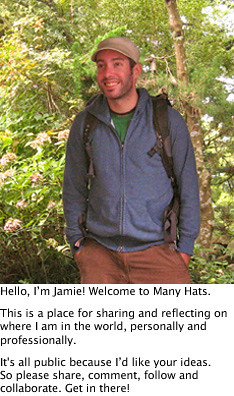A Greener Shade of School
I read an article today that got me thinking about the notion of Green or Environmental schools. The Hindu, an English-language Indian newspaper, featured the school Sholai Cloaat. A small “enviro-ed” school in the mountains of Tamil Nadu.
The Sholai School is the brainchild of Brian Jenkins. A Brit by birth, but long term resident of India. He founded the school out of inspiration gathered through study with his guru, Krishnamurthy and travelled 7000 km to find the right location. The campus borders on a national park, with frequent elephant sightings, is completely off the grid, and powered through a combination of solar energy and biogas. The students are a mixture of international expat kids and others from around India, but half are local scholarship students who pay no tuition. The curriculum meets the standards of the University of Cambridge syllabus, but is filled out with farming, waste management, carpentry and construction, trekking, bird watching, yoga and much much more. They’ve apparently been busy building an engine for Jenkins’ car, that can run on both petrol and biogas.
What strikes me about this is both its differences from other schools, and its similarities. I had a chance to visit the Green School in Bali a couple summers ago and many of the traits that we see at the Sholai School are evident here as well.
Both were started by foreign nationals with an environmental passion and a drive to reinvent education for expats as well as locals. Both subsidize and further their work by running programs for individuals from outside their regular student body. Both go to great lengths to form strong connections with the local communities and provide scholarship opportunities for local kids. Both clearly promote an integrated curriculum, based on an adopted set of standards (either Cambridge or IBO). Both have gone to great lengths to construct their campuses in a sustainable manner, based on local materials.

For one project, students learned different lashing and knot-tying techniques, and were tasked with building temporary shelters. From: Craig Cerhit, Maple Ridge News
A third school, The Environmental School Project (of Maple Ridge, BC, Canada), takes one extra step. As a member of a public school board, they are very clear about what makes them different. They go as far as to call their education system “place-based imaginative and ecological education”, reminding me of the Reggio Emilia Approach belief in the Environment as a teacher. This school drives home the notion for prospective families that the students will be spending time outdoors a lot. Whatever the weather. Kids will be safe and warm they say, but they may not have access to flushing toilets, and they will certainly be faced with new challenges on the way to seeing their skills flourish in the outdoors. Similarly to the other two institutes, this one also guarantees that they will deliver the provincial curriculum, but maintain that that is only a fraction of the learning that will be going on.
Read more:
Sholai School, Tamil Nadu: website, article from The Hindu
Green School, Bali: website, press page, CNN article
The Environmental School Project, British Columbia: website, article from Maple Ridge News
Other Schools worth a look:
Imagine: Environmental Charter School, Sunnyside Environmental School, Learning Gate: Community School
Related
6 Responses to A Greener Shade of School
Leave a Reply Cancel reply
This site uses Akismet to reduce spam. Learn how your comment data is processed.
MY CLASS BLOG
This is my classy, yet personal blog. For my less personal –but perhaps classier– classroom blogs, click here, or here.MANY HATS in your inbox
Subscribe to Many Hats...

many hats by Jamie Raskin is licensed under a Creative Commons Attribution-NonCommercial-ShareAlike 3.0 Unported License.Details… details…
CATEGORIES
@jamieraskin
My TweetsINVASION PROGRESS








































HISTORY
MANY COMMENTS











[…] A Greener Shade of School […]
Hey!
You should check this one out too!
https://www.facebook.com/PanyadenSchool
http://www.panyaden.ac.th/
Nice highlighting of these schools! As a parent who is not a trained educator, it seems to me that the entire ES curriculum would benefit from being based in nature-science studies…art, language arts, science, maths…it’s all there in front of us. Love the outside no matter what ethos…the kids’ preschool had that in Minnesota and even if they had to bundle all the children for 5 minutes outside, they did it!
I totally agree Rachel! I think, especially in as mild a climate as Japan, that we could really take on the ethos of “outdoor time”. As in, we go outdoors, every day, we wear what we need to to be comfortable, but we get out and play. I know there would be push-back from various places, certainly including the teachers who would be expected to keep an eye on things, but I think there would be real value to the default position of outside time being valuable enough not to let go of! Thanks for the comment!
Thanks for sharing these schools. It’s good to know that not only do these schools exist and they work with a national/international curriculum. There really is no excuse for not being more creative about what the school day should look like. Thanks.
Brian Jenkins is a white patriarchal man who runs the place like a Remanent of the British Raj. He has an extremely problematic zamindar attitude and has no accountability to anyone as he owns all the land. His staff are very afraid to speak up about the issues and are actually being harassed. Mr. Jenkins can’t stand being challenged and makes very inappropriate comments on women.